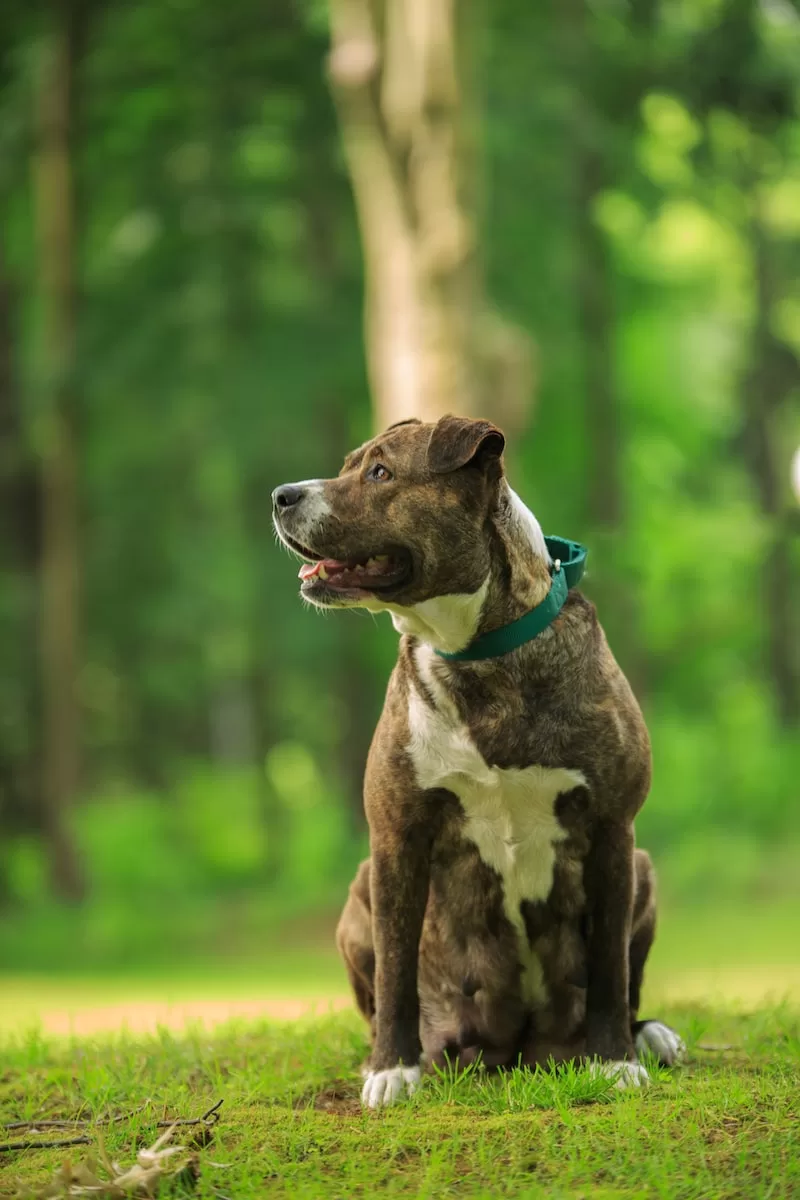Being the inhabitants of an ever-growing educated society, we all have become aware of breast cancer and its severe future impacts. But have we ever thought about the same with our beloved pets? Mammary cancer in dogs is similar to humans, where early detection could help them improve with time. Mammary cancer can be detected early, so the survival rates are much better for the dog than for late-detection mammary cancer cases.
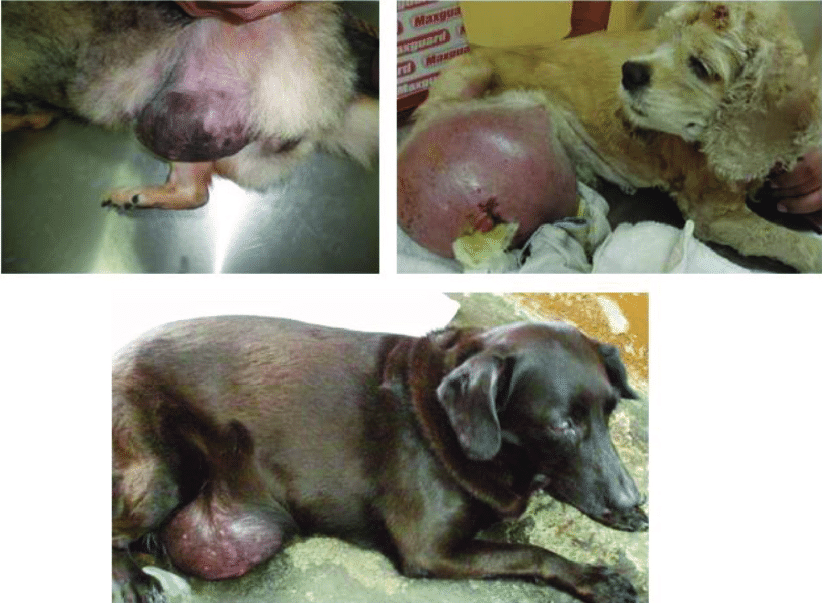
Most veterinarians have stated that mammary cancer in dogs is one of the most common forms of cancer, and it is found chiefly among unspayed female dogs aged between 5 and 10. You would be surprised to know that four out of five unspayed female dogs are affected by mammary (breast) cancer, while 50% come positive for malignancy. It’s a myth that female dogs only suffer from such cancer, but dog breast cancer is also found in male dogs simultaneously.
This article will explore the signs and symptoms of mammary cancer in dogs. We will also discuss what causes it and how it progresses so that you can better detect cancerous lumps in your pet’s breast tissue (and other body parts!) before they become a severe problem.

Also read How to Ease Halloween Anxiety in Dogs: 9 Important Considerations
First Off: What is Mammary Cancer in Dogs?
The cells that make up breast tissue reproduce abnormally, which leads to the development of a dog mammary tumour. Both benign (non-cancerous) and malignant mammary tumours in dogs are possible (cancerous). Malignant mammary tumours come in various forms, with carcinomas becoming the most prevalent. Epithelial (skin) cells, mammary gland tubules, or other cells in the mammary chain can give rise to cancer.
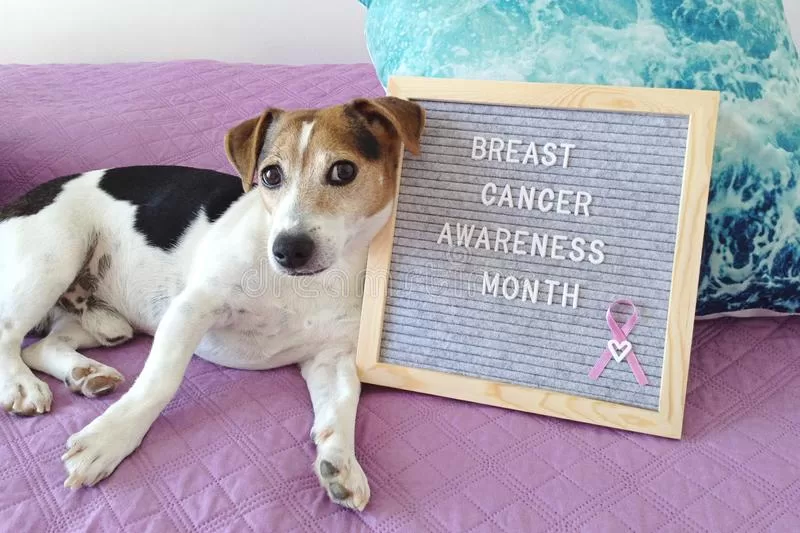
Female dogs have five pairs of mammaries on their abdomen, which typically begin beneath the upper arms and extend toward the groyne. The mammary glands’ job is to produce milk and nourish the dog’s pups. Many pups that are not neutered at an early age will continue to have litters throughout their lifetime, even though most animals are customarily desexed during their puppy years. Female dogs with prior litters frequently have noticeable, touchable or observable mammary glands.
Though the female dog does not necessarily need to have litters to get breast cancer, female dogs who get false pregnancy could also get mammary cancer. Before you notice any signs or symptoms of dog breast cancer, you must understand the possible causes of a dog getting prone to mammary cancer.

Also Read Can steroids cause Pancreatitis in dogs? Know 7 Important Things.
Causes of Breast Cancer in Dogs
Though mammary cancer in dogs occurs for several reasons, it is still not fully understood why some dogs develop breast cancer. Factors that may increase the risk of developing mammary tumours in dogs include:
Age
Age is the most significant risk factor for developing breast cancer in dogs. Most cases occur in dogs over 10, and the average age for diagnosis is 12 years old. Breeds (tiny ones) Female dogs spayed before their first heat cycle tend to be at lower risk than those not.
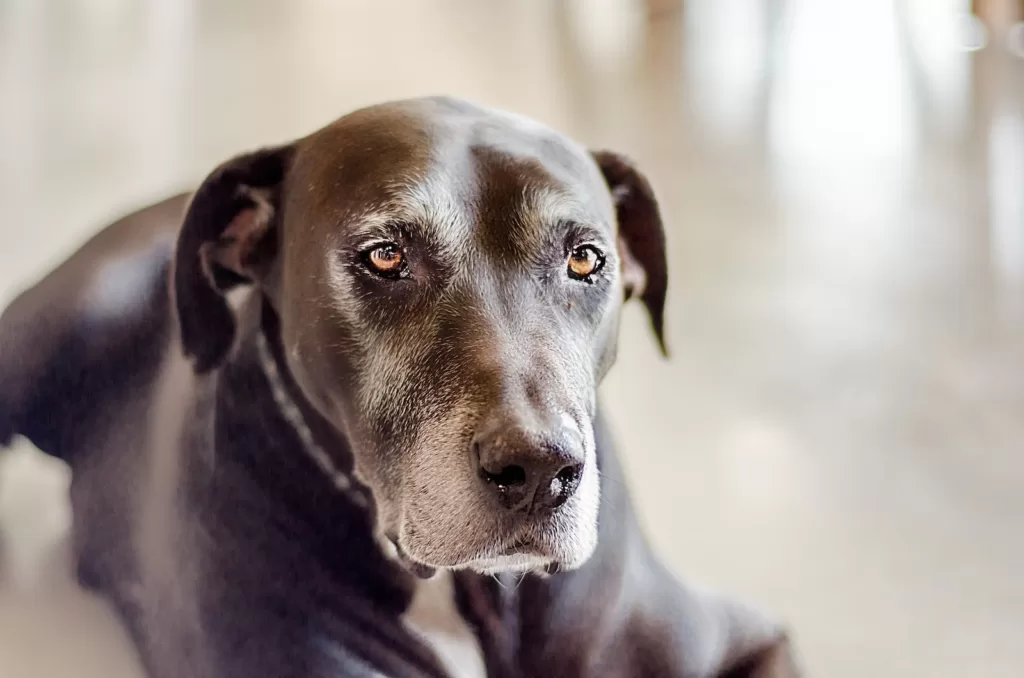
Breed and size
Sometimes, a dog’s breed and size play a crucial role in identifying chances of breast cancer in dogs. For instance, Cavalier King Charles Spaniels and Yorkshire Terriers are the most common breeds to develop mammary cancer. It is thought that smaller dogs have less circulating estrogen than larger ones, contributing to the increased risk of developing mammary tumours.
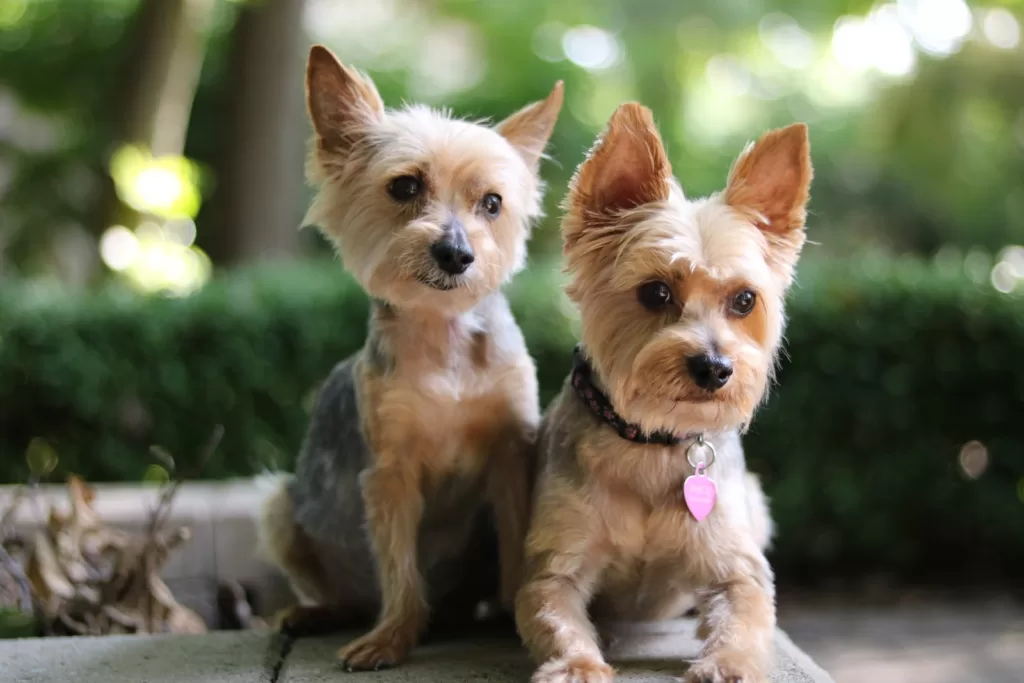
Hormonal Attributes
Hormonal factors significantly impact cancer development, specifically the hormone estrogen produced by female dogs’ ovaries. The longer estrogen is made in a female dog, the higher the likelihood of developing breast cancer. Consequently, older female dogs not neutered are more susceptible to breast cancer than younger ones.

Prior exposure to radiation or chemicals
This may increase the risk of developing mammary gland cancer in dogs. This is especially true for dogs treated with radiation for another type of cancer or chemotherapy to treat a disease like a lymphoma.
False Pregnancy
It is not a very commonly known factor that female dogs might get mammary cancer, even due to false pregnancy. Pet parents often miss that their female pets are lactating like a new dog mother. Now you must be thinking; Can phantom pregnancy in dogs cause cancer? A female dog suffering from pseudo-pregnancy could get mammary cancer due to mastitis or mammary gland infection if the lactation is not treated with either medication or manual milk extraction. The milk would form a lump after the false pregnancy and become severe infections leading to breast cancer in dogs.

Diagnosis of Breast Cancer in Dogs
During your veterinary appointment, the vet will begin by examining the mass or masses on your pet and gathering information about their size, texture, and movement. They will also ask for details about your pet’s medical history, such as their last heat cycle, current medications, and any previous or false pregnancies. While X-rays and ultrasounds can help visualize the spread of cancer, they may not detect microscopic cancer cells.
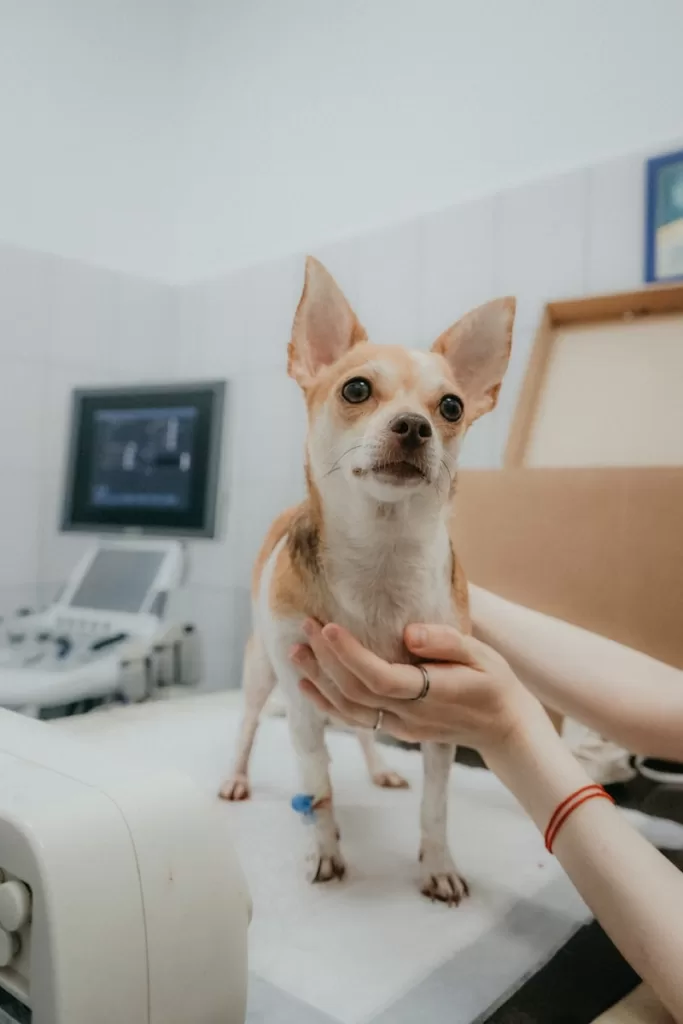
If your pet has tumours, the veterinary oncologist will usually recommend a fine needle biopsy and may also recommend the same procedure for the lymph nodes. Additionally, the vet will conduct general tests to check for any other health problems, such as a complete blood count, urinalysis, and blood chemistry profile. These tests will help determine if your pet is healthy enough to undergo surgery and anaesthesia. Once the tumours have been surgically removed, a biopsy will likely be necessary for a definitive diagnosis.

You can also test lumps or tumours at home on your pet to identify if she has any swelling around her mammary glands. You can perform a monthly routine checkup at home, pressing down the muscles of your pet’s mammary glands to see if any lumps have formed, especially during the heat cycle. Breast cancer diagnosis in dogs is based on a physical exam and biopsy. A biopsy is usually done by taking a sample of cells from the tumour and testing it for cancerous cells. If the test returns positive, surgery is recommended to remove all visible tumours and some surrounding tissue (called wide excision).
Also Read How To Apply CBD For Dogs: 7 Best Usage
This procedure takes about thirty minutes and will likely be done under sedation or general anesthesia, depending on how much tissue needs to be removed. Your veterinarian will discuss the options with you during your visit. If the biopsy returns negative, your dog may still be at risk for breast cancer. If you have a female dog with large breasts over one year old, talk to your veterinarian about whether mammary tumours should be removed regardless of whether they are malignant or benign.

Different Types of Mammary Tumors in dogs
As a common fact, we all know that there are mainly two types of tumours: benign and malignant. However, these two types also come in sub-types of tumours that differentiate the stages of mammary cancer in dogs.
Adenoma: it refers to a noncancerous glandular tumour. Although it is typically considered benign, in some cases, it can become cancerous.
Carcinoma: it pertains to malignant growths composed of epithelial cells. Examples of canine breast cancer carcinomas include adenocarcinomas and inflammatory carcinomas.
Carcinosarcoma: these are tumours that are comprised of a combination of epithelial cells and cells from other tissues.
Fibroadenoma: it is a type of benign, painless tumour that originates from the combination of skin and connective tissues. These tumours tend to move within the breast tissue.
Sarcoma: a group of malignant bone, cartilage, or fat cell tumours. Sarcomas are a relatively uncommon cause of canine breast cancer.

10 Signs of Mammary Cancer in Dogs
While we are concerned about our pet’s health, knowing the signs and symptoms of breast cancer in dogs is essential. This can help pet parents and people who want to get a dog in future to become aware of the illness. Here are ten signs of mammary cancer in dogs that you can look for if needed.
1. A Lump
A lump or mass on the breast is the most common sign of mammary cancer in dogs. The mass can be anywhere from under one centimetre in diameter to as large as 10 centimetres. Depending on size, it may feel like a tiny pea or golf ball. Lumps that are red, pink, or purple are more likely to be malignant than white or yellow ones.
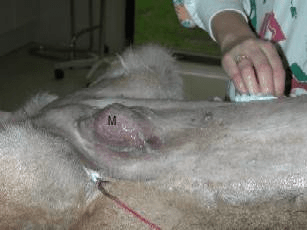
2. A Swollen Breast/s
Swollen mammary glands after the first heat can indicate breast cancer in dogs. The swelling may be on only one breast or both sides. It may feel firm to the touch or somewhat soft, depending on how advanced the cancer is at diagnosis. You may want to examine your dog’s breasts for lumps or swelling once a week, then once every two or three weeks.
3. An Involuted Nipple
An involuted nipple is a common symptom of mammary cancer in dogs. In this case, the nipple has pulled back into the breast, and you can’t see it anymore. If you notice this change in one or both of your dog’s nipples, contact your veterinarian immediately.
Involuted nipples signify that cancer has spread to the lymph nodes under the armpit and may be a harbinger of the disease’s metastasis or spread. Please do not confuse it with an inverted nipple. An inverted nipple is a normal part of your dog’s anatomy and will not cause health problems.
4. Discharge From the Nipple
If you notice that your dog is producing discharge from her nipple, it’s time to see the vet. This can signify mammary tumours in dogs—it’s more common in females than males—and is usually transparent or bloody yellow-green. If you notice fluid coming from your dog’s vaginal opening (the one through which puppies are born), take her to see a vet immediately so he or she can find out what is causing it and treat the problem appropriately.
5. Skin Discoloration or Broken Skin Over The Tumor
It could signify infection if you notice skin discolouration or broken skin over the tumour. This happens when bacteria enter your dog’s body due to an open wound caused by a tumour that wasn’t previously detected. The discolouration can look like a red or purple streak along the skin, which indicates that blood has been drawn into the tumour. If this happens, take your dog to see a vet immediately so he or she can drain the area and treat it appropriately.

6. Painful Pressure Points
If you notice that your dog has tender pressure points, this could signify mammary cancer. A lump or swelling in one or both of your dog’s armpits is another telltale sign of the disease. Pressure points can be painful, especially when your dog is walking or running around.
This means your dog will either want to stop moving altogether or move slowly so as not to feel pain. If you notice a lump at the base of your dog’s tailbone, it could also be a sign of cancer.
7. Sore or Soreness Near The Tumors
If your dog is sore in a specific spot, it could be a sign of mammary cancer. If there’s an area where your dog seems incredibly tender, this could be because of a tumour growing beneath the skin and causing pressure on nerves in that region.

8. Lack of Appetite
A lack of appetite is a common sign of cancer in dogs, and it’s often the first sign that something is wrong. If your dog isn’t eating as much as usual, don’t worry; sometimes, dogs lose their appetite when stressed or ill. However, it could signify something more serious if he doesn’t want to eat for more than two days in a row.
If your dog is losing weight and not eating, consult your vet immediately. Lack of appetite in dogs is also a symptom of other conditions, such as diabetes and kidney disease, so it’s important to rule out those possibilities before assuming your dog is sick.

9. Bad Odor Nearby Mammary Glands
The smell of a mammary tumour can be rancid fish, ammonia, or even urine or faeces. This is because the tumour is secreting different fluids with different odours.
Notice a foul odour near your dog’s mammary glands (not necessarily the mammary gland/s itself). It could indicate that something is wrong with them. Although the foul odour’s cause is unknown, it could be due to the presence of bacteria or yeast.
10. Your Dog Is Unsettled
If your dog is unsettled, whining, shaking, or crying when you try to handle nearby areas or rub her belly, relinquish touch on specific spots. This can be a sign of mammary cancer. It’s important to note that it could be entirely different if this happens suddenly after an injury or surgery! If your dog has been injured recently and starts acting strangely toward her mammary glands (or any other part of her body), it could indicate an infection instead of cancerous growth in the breast tissue.

The signs of delinquent behaviour can vary based on the dog, but it’s essential to watch for sudden changes in your dog’s behaviour. It could signify that something is wrong if you notice that she is unhappy or unwell at certain times.
Treatment for Mammary Cancer in Dogs
If your dog is diagnosed with breast cancer, it’s essential to know that this type of cancer can be treated. Dogs with breast cancer can live long, healthy lives. However, treating dogs with breast cancer will differ from how humans treat the disease.
Simple tumour excision is often sufficient for dogs with solitary mammary tumours less than 1.5 cm in diameter. A mastectomy can be performed to remove the entire breast if a dog has multiple tumours in its breast tissue. This surgery does not hinder a dog’s ability to reproduce.
Mastectomy may not be enough to treat such large tumours. The most common treatment for dogs with metastatic cancer is a combination of chemotherapy and radiation therapy. This approach can extend your dog’s life by months or even years, but it does not cure cancer.
While your pup is going through such tremendous mental and physical pain, you need to keep in mind to provide loads of love and comfort to your furbaby.
FAQS
How long does a dog live with mammary cancer?
The length of time a dog with breast cancer survives might vary based on a number of variables, including the disease’s stage, the dog’s age and general health, and the kind of treatment given.
If the cancer is detected early and is only in its initial stages, the prognosis for a dog can be relatively good with an expected survival time of one to two years. However, if the cancer has spread to other organs or lymph nodes, the prognosis can be poor, and survival time can be as little as a few months (9 to 12 months).
It’s important to note that each dog’s situation is unique, and it’s best to discuss the prognosis and treatment options with a veterinarian who can provide a more accurate estimate based on the individual dog’s case.
Can dogs survive mammary cancer?
Dogs can recover from breast cancer, yes. The stage of the disease, the dog’s general health, and the type of treatment given all affect the dog’s prognosis for developing mammary cancer.
Early detection and treatment are vital in improving a dog’s chances of surviving mammary cancer. It’s essential to have your dog regularly examined by a veterinarian and report any lumps or bumps you notice during at-home checks.
How aggressive is mammary cancer in dogs?
Mammary cancer in dogs can be aggressive and spread to other parts of the body if left untreated, making early detection and treatment necessary for improving the dog’s prognosis.
What causes mammary tumours in dogs?
Hormones: Mammary tumours are more likely to form in female dogs not spayed or spayed later in life.
Genetics: It has been discovered that some breeds, including poodles, terriers, and spaniels, are more prone to developing breast tumours.
Age: Mammary tumours are more prone to form in older dogs.
Environmental factors: Exposure to specific chemicals and contaminants may increase the risk of mammary tumours.
Obesity: It has been discovered that obese or overweight dogs are more likely to develop mammary tumours.
Summing Up
We hope that you better understand how to detect mammary cancer in dogs. It is essential to be aware of the warning signs so that if something does seem off with your pet’s breasts, it can be caught early on before it becomes more serious. Early-stage mammary tumours in dogs are often not painful and can be removed with surgery. Once cancer has spread, however, treatment options are limited but can be painful for your pup.

